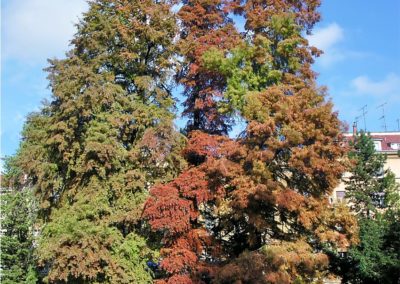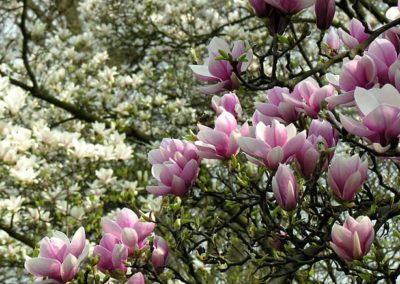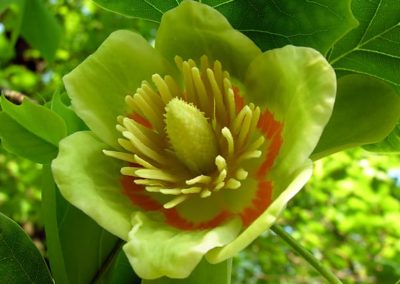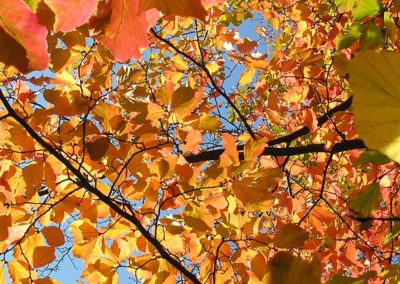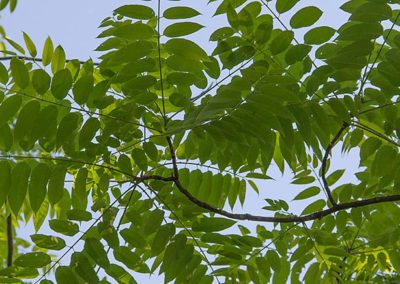Arboretum
- HOME
- COLLECTIONS

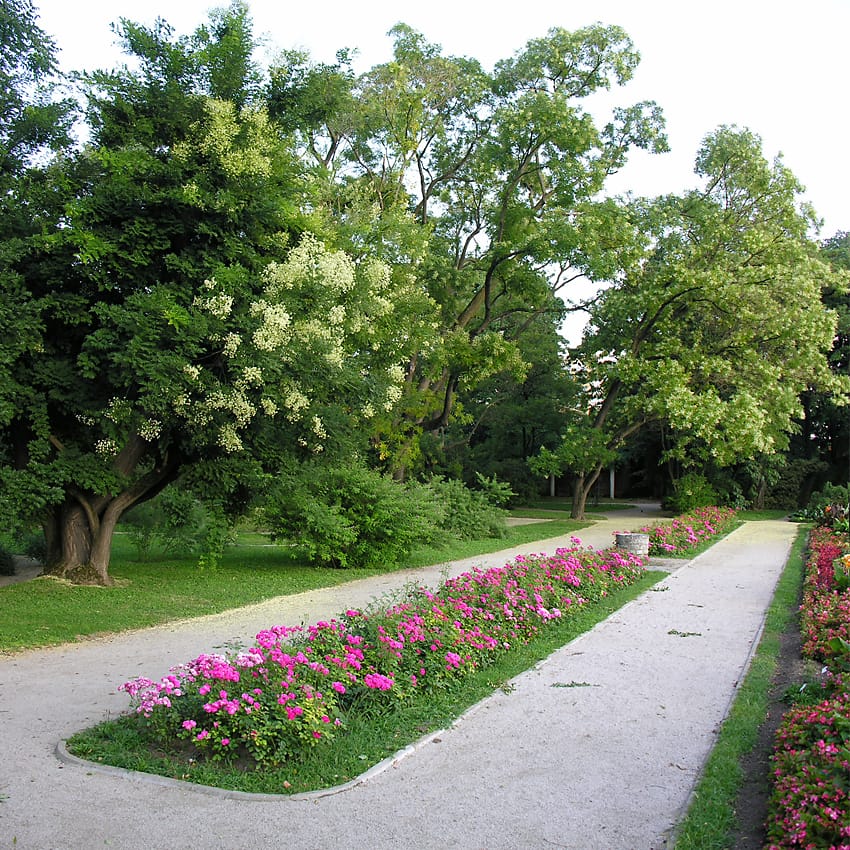
Arboretum
The arboretum is designed as a landscape garden – in the ‘English’ style. This style was devised during 17th and 18th century as a contrast to strictness and formality of the omnipresent baroque gardens found by every castle in Europe (Versailles, Schoenbrunn, Leipzig etc.). This ‘French’ style was slowly replaced with informal gardens with open spaces, winding paths, lawns with groups of trees and often with artificial lakes and creeks, even grottos – all representing a romanticised nature. Plant hunters are bringing new exciting species from all over the world, particularly trees and shrubs which today shape known sceneries along famous mansions and palaces. Botanical gardens also host new collections, which causes their expansion and increase in size.
Most of those plants come form temperate climate areas and have well adapted to city living conditions. Several taxa are sensitive to freezing temperatures and must be protected with special foils and dry leaves during the winter, e.g. camellias. However, during the last decades we experience shorter and warmer winter periods so we are able to plant Mediterranean plants outside the greenhouses. Summers are sometimes hot and dry and at other times very rainy; this instability in the climate and an increase in extremes cause temperate forest species like oaks, beeches, hornbeams and maples, to stagnate and live shorter. Plants definitely confirm the global warming and climate change!
The arboretum is divided into 53 irregular plots or fields intersected with winding paths, and it takes approximately 3 out of entire 4.7 hectares of the Garden total area. Plots are planted with 200 different genera containing 700 taxa of trees and shrubs all over the world.
Most of those plants come form temperate climate areas and have well adapted to city living conditions. Several taxa are sensitive to freezing temperatures and must be protected with special foils and dry leaves during the winter, e.g. camellias. However, during the last decades we experience shorter and warmer winter periods so we are able to plant Mediterranean plants outside the greenhouses. Summers are sometimes hot and dry and at other times very rainy; this instability in the climate and an increase in extremes cause temperate forest species like oaks, beeches, hornbeams and maples, to stagnate and live shorter. Plants definitely confirm the global warming and climate change!
The best way to get to know our arboretum is to take a long walk, but let us mention the most important groups and specimens;
To the east from the main entrance, in the plot no. 1 (P1) grows an evolutionary old group of plants, the gymnosperms, with ancient members such as araucarias and the ginkgo and a bit younger plants like conifers – members of different genera, e.g. pines (Pinus), spruces (Picea), firs (Abies), junipers (Juniperus), arborvitaes (Thuja) and other evergreens. Three large 100-year old swamp cypresses are beautiful through the year, until the winter, as this is one of the rare deciduous conifers that loses its needles every autumn.
Another member from the same subfamily grows along the western fence (P45) – dawn redwood (Metasequoia glyptostroboides), discovered in China in 1941. Until then it was known only from fossil records. Such an old and evolutionary conservative plants (and animals) with many primitive (ancient) characteristics, we often call ‘living fossils’.
Another living fossil is the ginkgo or maidenhair tree (Ginkgo biloba) growing in P5, P6 and P45. It is the sole surviving species within the ginkgo family, which dates back to the Jurassic epoch. It survived in the wild only in China, but is planted in parks and gardens all over the world due to decorative fan-shaped leaves, resilience to city pollution and lovely autumn golden colour of the leaves. Only the male trees are planted in order to avoid production seeds, which have malodorous fleshy coat.
One of the most famous living fossils and the greatest botanical discovery of our time is a plant discovered in 1994 in a hidden canyon of the Australian Wollemi national park, not a 100 miles away from Sydney. This is so called Wollemi pine (Wollemia nobilis) belonging to the araucaria family (Araucariaceae), thought to be extinct and only known from fossils. Our specimen was planted on the 20th anniversary of its discovery. It is protected by a small cage which both attract the visitors and is useful for protecting this subtropical tree from winter cold.
Part of the conifer collection is planted in P45, P51 and P52, with such interesting species as the giant sequoia (Sequoiadendron giganteum) – the largest living organism in the world and its relative the coastal redwood (Sequoia sempervirens), somewhat thinner but up to 120 meters tall tree.
Across from the main entrance in the P13-16, P38-40 we are growing the oldest and the most primitive angiosperms (plants with real flowers), such as the members of the magnolia family (Magnoliaceae). Cultivars of the soulangeana hybrids (Magnolia x soulangeana) such as ‘Picture’, ‘Lennei’, ‘Alexandrina’ and ‘Rustica Rubra’ bloom before emergence of their leaves. Unlike the hybrids and most Asian species, the American magnolias tend to flower after they develop leaves. The large tulip trees (Liriodendron tulipifera) in the P13, P39 and P40 belong to the same family and are adorned with tulip-like green and orange flowers in late spring.
The other spring-flowering shrubs and trees usually belong to the family of roses (Rosaceae); flowering cherries (Prunus) and crab-apples (Malus) grow along the northern fence, e.g. Japanese flowering cherry, Prunus serrulata ‘Kanzan’ its large pale pink inflorescences. Several genera of shrub are blooming later in the spring – spiraeas, cotoneasters and serviceberries (Amelanchier).
The roses (Rosa) are cultivated in several sunny spots in the Garden. Wild, bush-like species and old cultivars grow in the P15, e.g. beautiful and scented flowered cultivar of Bourbon rose ‘Variegata di Bologna’ and Chinese yellow or Father Hugo’s rose (Rosa hugonis). Different garden roses (groups like Polyantha roses, Tea roses, Floribunda roses etc.) grow in the floral parterre and near the fountain. We also grow several climbing roses up the walls of the head office house, such as the cultivar ‘Sympathie’ with bright red and perfume scented flowers and the Lady Banks’ rose (Rosa banksiae ‘Lutea’) with bouquets of tiny pale yellow flowers.
In the central part of the arboretum (P27) you will find an interesting and rather rare tree – the handkerchief tree (Davidia involucrata var. vilmoriniana) from China. It is special because of its unusual, large, hanging white bracts hiding the spherical flowers. These bracts adorn the tree in late spring, looking like handkerchiefs or doves, hence its common names. A few steps away (P17) there is another fascinating specimen, a 100 year-old Persian ironwood (Parrotia persica). Spontaneously rooting or layering the lowest branches, it achieves the form we see in the Garden, extending in the width more than in the height. In the autumn, the leaves change colour: some remain green, while others turn yellow, orange or even red.
Adjacent to Persian ironwood (P18) are the tallest trees in the Garden, hybrid or London planes (Platanus x hispanica). The planes (Platanus spp.) comprise about ten species, of which eight are Mexican and North American. The most widely distributed plane tree is a cross between the American (P. occidentalis) and the Oriental Plane (P. orientalis, P16), also known as the London Plane (P. × hispanica, P18). This is the tree that we can see in the gardens and the avenues of the cities around the world (like Zrinjevac Park in Zagreb), and in the various regions, where it is planted for its fast growth, resistance to harsh winters and dry summers, as well as its tolerance of air pollution. It can grow up to 40 metres tall, chaotically spreading its large, thick branches in all directions unless it is regularly pruned and shaped. Our specimens are the tallest trees in the Garden, at about 33 m tall.
In the plots 34-40 we grow mostly Asian representatives of the soapberry family (Sapindaceae), the rue family (Rutaceae) and the mahogany family (Meliaceae). The most valuable is a specimen of the Chinese Toon also known as the Chinese mahogany (Toona sinensis). As the most resistant species of its genus, it is widespread in eastern and south-eastern Asia where its young leaves are used for food. Its hard and decorative, reddish wood that resembles the true mahogany (genus Swietenia).
Towards the south in the P8 and P35 you can find members of the birch family (Betulaceae) and the beech family (Fagaceae), e.g. beeches (Fagus), oaks (Quercus) and alders (Alnus).
The beeches are, together with the oaks and the sweet chestnuts, the most important genera of the beech family of the northern hemisphere. In contrast to the oaks, there are only about a dozen types of beeches, one North American, three European and those originating from China, Japan and Korea. In a mature forest, the beech is the dominant tree. Its dense crown blocks the light and its strong roots prevent the growth of competing plants, so that the ground remains almost naked. In small gardens, the common or European Beech (Fagus sylvatica, P7) is often present, at least as a hedge. In avenues, it can reach a height up to 40 metres. It distinguishes by its silver-grey bark and light green leaves with wavy edges. Solitary beech trees often have long branches that bend down to the ground to protect their sensitive bark from the sun. The European Beech is a source of the most interesting cultivars. Distinct colouration of the leaves is characteristic of the following cultivars: F. sylvatica ‘Tricolor’ grows light green leaves with pink edges in springtime (P53), and ‘Atropunicea’ has dark purple leaves (P7, P53). The leaves can be round (e.g. cultivar ‘Rotundifolia’), extremely reduced and narrow (e.g. ‘Mercedes’) or feathery (‘Asplenifolia‘, P7d).
From several oak species growing in the P8 let us draw your attention to our oldest tree, the pedunculate Oak (Quercus robur) standing on the edge of the systematic filed. It is 28 m tall with a trunk girth of 430 centimetres. The estimated age of this probably wild tree is about 200 years. Its wide, open and branched crown tells us that it grew as a solitary tree without sun deprivation for the first few decades, perhaps as part of a grove, but later in the open space of one of the meadows leading towards the town from the south.
In the P34, P35 i P41 we are growing species of maple genus (Acer); There are only a few maples native to Europe, although some of the largest, most interesting species, and the most frequently planted cultivars count among them. Such is the Norway Maple (A. platanoides) and its black red-leaved cultivar ‘Crimson King’ as well as the Sycamore (A. pseudoplatanus) with one of the oldest maple cultivars with white-yellow spotted leaves named ‘Leopoldii’. The most frequently cultivated oriental maples are the Japanese maple (A. palmatum, P41), its numerous cultivars (e. g. Red-leaved ‘Atropurpureum’, P41) and the cultivars of the full moon maple (A. japonicum), especially the famous ‘Aconitifolium’ with deeply lobed leaves (P41). Some Asian species are hard to recognise as maples because they have unlobed leaves, not the characteristically palmate ones. The simple-leaved maples are, for example, the Japanese hornbeam maple (A. carpinifolium, P41) and the Chinese species Père David’s maple (A. davidii, P35b).
Along the maples in the P35 and P41, across the gazebo, there are several representatives of the dogwood family (Cornaceae), for instance the European cornel (Cornus mas), a deciduous shrub or a small tree, not exceeding 12 metres, noticed among other woody plants because of its inflorescences of yellowish flowers that appear on naked branches in February and March. The Cornel’s fruits are drupes with red pericarps, at first very bitter, but edible after they fall from the tree. Nowadays, cornels are rather neglected as useful and ornamental species as priority is now given to the American and Asian dogwoods (P17, P41), which are cultivated for their large false ‘flowers’.
The small trees with weeping branches that are growing in parterre corners are the ‘Pendula’ cultivar of the pagoda tree, or weeping Japanese pagoda trees (Sophora japonica ‘Pendula’). Due to its attractiveness and dwarf growth, this cultivar is planted more often than the wild, ‘common’ species that can reach up to 15 metres in height, and which can be seen along the eastern path of the parterre (P27 and P28). Despite its scientific name, this tree species is native to the Chinese mountains and was introduced to Japan with the spread of Buddhism. The Pagoda Tree blooms in summer with big cymose inflorescences composed of fragrant, tiny, yellow-white flowers, which can even be ‘heard’, so to say, because of the thousands of bees buzzing around looking for the nectar.
West to the parterre (P46-49), except the trees you can notice many interesting shrubs from the honeysuckle family (Caprifoliaceae); among the weigelas (Weigela spp.), the most frequent are the cultivars of the pink weigela (W. florida), grown for their funnel-shaped, brightly coloured flowers, such as the dark pink flowers of the ‘Bristol Ruby’ cultivar. The beauty bush (Kolkwitzia amabilis), the only species of its genus, native to central China, is considered one of the most beautiful species of this family. The honeysuckles, with about 180 species belonging to the genus Lonicera, 20 of which are European, include mainly climbers with attractive flowers. Members of the deadnettle family (Lamiaceae) are interesting for their attractive autumn fruits; Japanese beautyberry (Callicarpa japonica) bears many purple bead-like fruits and the harlequin glorybower (Clerodendrum trichotomum), also a Japanese species, has dark blue drupes wrapped with magenta-red star-shaped calyx on maturity.
Since botanical garden is not just a public park, its collections contain not only ‘pretty’ plants, but also botanically and medicinally interesting species, some of them the being poisonous or allergenic. Therefore we advise you not to touch the plants in the arboretum and especially to keep an eye on children!
Tree care and arboriculture
Most trees in the arboretum are more than 50 years old, but we also have several centennials. Even though 50-100 years is just a part of a lifespan of many tree species, we consider ours to be quite old because here at the Botanical garden they are growing in an unnatural and unfavourable environment: the heavy loamy soil retains too much water, the air is polluted with car exhaust fumes, and during the summer months the Garden is surrounded by hot city asphalt. Many of our trees come from different parts of the world and have been gradually and carefully acclimatised to our continental i climate. Shrubs and trees from either colder places (mountains) or warmer places (the Mediterranean) grow successfully in the arboretum, but their lifespan is usually shortened because they have to ‘fight’ the unpleasant climatic conditions and are therefore physiologically exhausted.
The trees are regularly inspected and pruned as necessary, and their stability is checked using modern diagnostic tools, e.g. resistographs an ultrasound, with calculation of their statics. Older trees which no longer have the ‘right’ habitus, we shape and keep safe and use them as habitat trees for bird and bats. Sometimes, due to severe wood rot, we have to cut down a tree, but usually this s the last step after strong formative pruning. We apologize for the occasional noise from machines or chain-saws and for the temporary closing of some paths. All the work is carried out by professional certified arborists which use ropes for climbing – we try not the use heavy cranes and any equipment that would damage our plants or the Garden itself.
Despite regular control, some changes in the tree trunk or roots that are not visible remain undetected and it can happen that an old tree fells during a storm or after long and heavy rainfall. Small, dead branches and twigs are shed during strong wind, which is a natural process of ‘self-cleaning’ but can be dangerous for the passer-by if they fall from 20 meters or higher.
Therefore we ask you not to take cover under trees during stormy and windy weather, for your own safety.








